
December 7, 2007

A new species of tickspider (Ricinoides sp. n.). Photo by Piotr Naskrecki (CI)
Conservation International has announced findings from their 2006 expedition to Ghana’s Atewa Range Forest Reserve (Atewa) led by CI’s Rapid Assessment Program (RAP), which include news of nine new species discoveries. The report was released to the public on December 6, 2007.
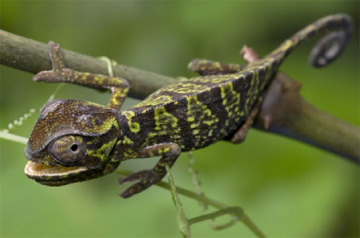
Chameleon Chamaeleo gracilis. Photo by Piotr Naskrecki (CI)
The RAP discoveries include a Critically Endangered frog species (Conraua derooi) whose presence in Atewa may represent the last viable population in the world; an unusually high 22 species of large mammals and six species of primates including two species of global conservation concern: Geoffroy’s pied colobus (Colobus vellerosus) and the olive colobus (Procolobus verus); 17 rare butterfly species; six bird species of global conservation concern including the brown-cheeked hornbill (Bycanistes cylindricus) and the Nimba flycatcher (Melaenornis annamarulae), recorded for the first time in Ghana; and nine species new to science: a tickspider and eight species of katydids.
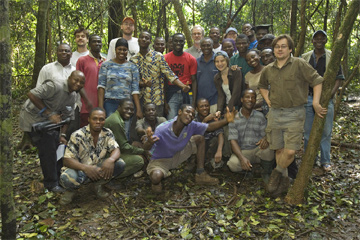
The Atewa RAP team. Photo by Piotr Naskrecki (CI)
Between June 6 – 24, 2006, a team of 22 scientists, post-graduate students and assistants from Ghana and abroad surveyed the 58,472 acre (23,665 hectare) Atewa tract in south-eastern Ghana, just two hours from the capital Accra. The scientists found an intact forest ecosystem, which is unusual and significant for West Africa, where most forests are highly fragmented and disturbed.
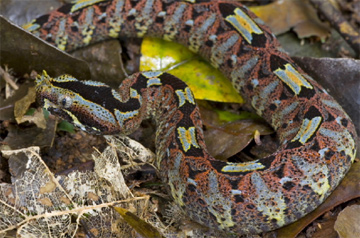
Rhinoceros viper (Bitis nasicornis). Photo by Piotr Naskrecki (CI)
Established as a national forest reserve in 1926, and since as one of Ghana’s Globally Significant Biodiversity Areas, Atewa’s importance has long been recognized because it contains the headwaters of three river systems, essential sources of domestic, agricultural and industrial water for local communities and many of Ghana’s major population centers, including Accra.
The aquatic Conraua derooi is Critically Endangered and may have its largest populations in the Atewa Range Forest Reserve. Photo by Piotr Naskrecki (CI)
Findings from Conservation International’s Atewa RAP report include:
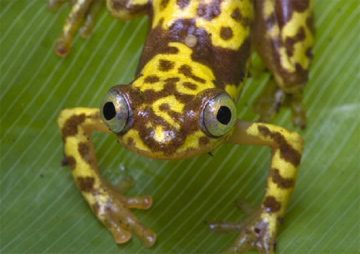
Frog (Afrixalus vebekensis). Photo by Piotr Naskrecki (CI)
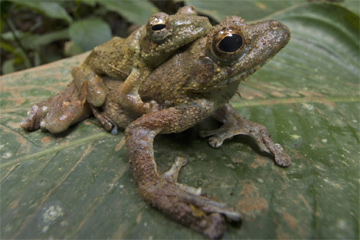
Tree frogs in amplexus (Chiromantis rufescens). Photo by Piotr Naskrecki (CI)
A Critically Endangered frog (Conraua derooi) whose presence in Atewa may represent the last viable population in the world.
A new species of tickspider (pictured at top) whose lineage is as old as the dinosaurs. This strange little creature looks like a cross between a spider and a crab, and males have their reproductive organs on their legs. They are considered quite rare, with only 57 other species known from this group throughout the world.
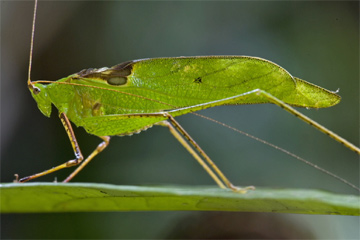
A new species of katydid (Tetraconcha sp. n.). Photo by Piotr Naskrecki (CI).
The highest diversity of katydids (aligned with the grasshoppers) in all of Africa, including eight species new to science, making 13% of all species of katydids in Atewa new to science.
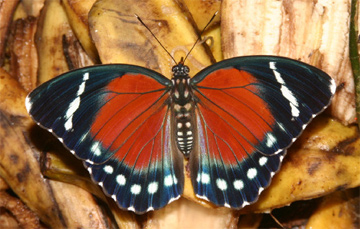
The Green Orange Forester – Euphaedra zampa (female; the male is metallic green) is endemic to the forests west of the Dahomey Gap. It is rare everywhere in Ghana except Atewa, where can be the commonest Euphaedra. Photo by Szabolcs Sáfián (CI).
The highest diversity of butterflies in Ghana, featuring 575 of the 925 species known to occur in Ghana – which is 62% of Ghana’s butterfly fauna and twice the number of butterflies found in Europe.
Seventeen species of rare butterflies, half of which are found only in Atewa or one other site in Ghana, including the magnificent Papilio antimachus, whose wingspan is the widest in the world.
A butterfly (Mylothris atewa) that is found nowhere else in the world and has been proposed as globally Critically Endangered. This status awaits confirmation by IUCN. The RAP report contains the first photo of this species in the wild.
Ten mammal species of global and national conservation concern, including the IUCN Red Listed monkeys: Geoffroy’s pied colobus (Colobus vellerosus) and the olive colobus (Procolobus verus).
An unusually high 155 bird species. Six species of global conservation concern including the brown-cheeked hornbill and the Nimba flycatcher (first time recorded in Ghana).
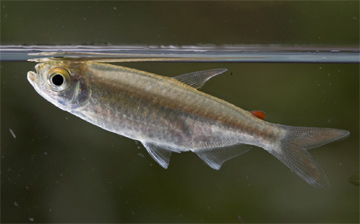
African tetra (Micralestes occidentalis). Photo by Piotr Naskrecki (CI).
Nineteen fish species of significant potential value in the aquarium trade. These species indicate that the streams run through high quality, intact forest, which is becoming exceedingly rare in West Africa.
The only tree fern species (Cyathea manniana) found in Ghana. Other places where similar species are found include forests in Brazil and Madagascar.
Sources: Press releases and other material from wire services, Conservation International, Science Daily, and Mongabay.
About Loren Coleman
Loren Coleman is one of the world’s leading cryptozoologists, some say “the” leading living cryptozoologist. Certainly, he is acknowledged as the current living American researcher and writer who has most popularized cryptozoology in the late 20th and early 21st centuries.
Starting his fieldwork and investigations in 1960, after traveling and trekking extensively in pursuit of cryptozoological mysteries, Coleman began writing to share his experiences in 1969. An honorary member of Ivan T. Sanderson’s Society for the Investigation of the Unexplained in the 1970s, Coleman has been bestowed with similar honorary memberships of the North Idaho College Cryptozoology Club in 1983, and in subsequent years, that of the British Columbia Scientific Cryptozoology Club, CryptoSafari International, and other international organizations. He was also a Life Member and Benefactor of the International Society of Cryptozoology (now-defunct).
Loren Coleman’s daily blog, as a member of the Cryptomundo Team, served as an ongoing avenue of communication for the ever-growing body of cryptozoo news from 2005 through 2013. He returned as an infrequent contributor beginning Halloween week of 2015.
Coleman is the founder in 2003, and current director of the International Cryptozoology Museum in Portland, Maine.
Filed under Breaking News, Cryptotourism, CryptoZoo News, Cryptozoologists, Cryptozoology, Expedition Reports, New Species, Photos